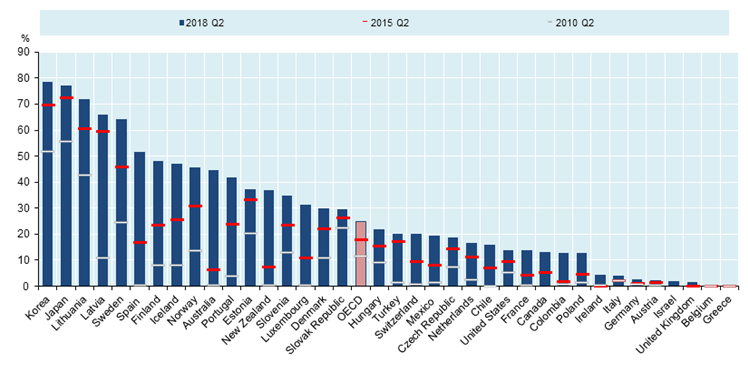The share of fibre optic as part of the total number of broadband connections in Australia is accelerating, new statistics from the Organisation of Economic Cooperation and Development shows.

Whereas in 2015 fibre subscriptions were less than ten percent of all broadband connections in Australia, three years later they amounted to 45 percent of the total.
OECD says the highest growth in fibre subscriptions last year were in Ireland where they rose by 218 percent, followed by Belgium and Australia with 71 and 70 percent.
Greece, Belgium, the United Kingdom, Israel, Austria, Germany, Italy and Ireland had the lowest proportion of fibre connections for fixed broadband delivery, with no country hitting ten percent of the total in June 2018.
On average, fibre fixed broadband connections in the 37 countries OECD collected statistics from went up to 25 percent from 12 percent eight years ago, the organisation says.
As of June last year, fixed broadband connections in the OECD increased to 411 million from 398 million in 2017.
Digital subscriber line (DSL) broadband delivered over copper phone cable remains the most used technology in the OECD, with 38 percent of all connections.
However, DSL fixed broadband connections continue to be replaced by fibre, and dropped by eight percent year on year. Fibre connections in comparison rose by 15 percent in the OECD during the same period of time.
Mobile broadband reached 106 percent per 100 habitants in the OECD, as the area added a further 98 million subscribers in the year to June 2018.
Australia has one of the highest mobile broadband penetration rates in the OECD at 136 percent per 100 habitants, behind the United States (137 percent), Estonia (146 percent), Finland (155 percent) and Japan (168 percent).



_(20).jpg&h=140&w=231&c=1&s=0)
.png&h=140&w=231&c=1&s=0)
_(22).jpg&h=140&w=231&c=1&s=0)



_(26).jpg&w=100&c=1&s=0)

 iTnews Executive Retreat - Security Leaders Edition
iTnews Executive Retreat - Security Leaders Edition












_(1).jpg&h=140&w=231&c=1&s=0)



